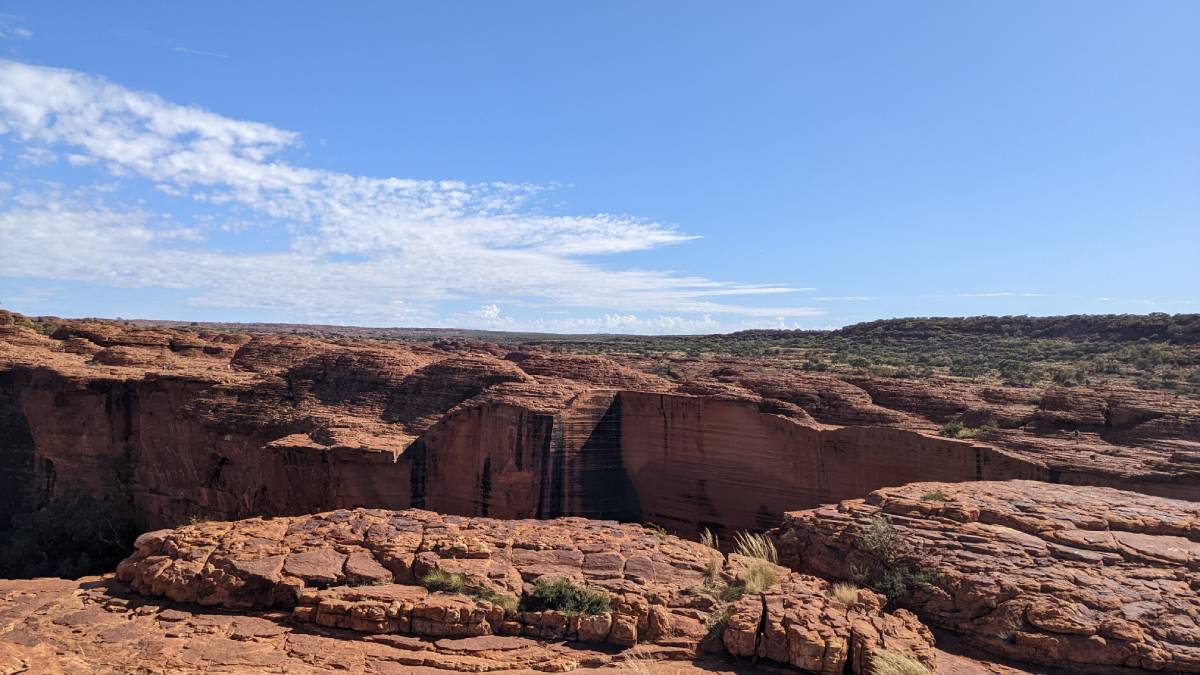Why does Australia only have forests on the coasts? To leave room for desert.
Dad jokes aside, central Australia is every bit as flat and sandy as its reputation suggests. Until all of a sudden it isn’t, because a giant rock, measuring 348m tall and 9.4km in circumference, rises formidably from the red earth that surrounds it.
Uluru (formerly known as Ayers Rock), is perhaps Australia’s most famous and recognisable natural landmark.
It’s an awe-inspiring and entirely unique sight, a combination that makes it a must-see for any backpacker travelling to Oz.
What and where is Uluru? How do you get there? Where do you stay and what do you do there? Having recently made the trip myself, I’d be glad to tell you all you need to know.
Where is Uluru, and how do I get there?
It would be fair to label Uluru ‘remote’. There are a few ways to define the centre of Australia, and Uluru is close to all of them. It is located 335km south-west of Alice Springs, a small city of 25,000 which itself is 1500km from the closest major cities (Darwin and Adelaide).
Most visitors either drive or fly to Uluru. There are also regular bus services between Uluru and Alice Springs, and you can get to Alice by train from Darwin and Adelaide (The Ghan).
Map of all the key locations at Uluru, Yulara and Alice Springs:
Via Alice Springs
Alice Springs is an obvious stop on your Uluru visit, as this unique city is a destination all its own.
Alice Springs Airport offers direct connections to every Australian state capital except for Hobart, and tends to be cheaper to fly into than Ayers Rock Airport (more on that later). Many Uluru visitors fly to Alice then hire a car for the final leg, though at five hours each way, this is no day trip.
Alice Springs has plenty of high quality, backpacker-focused accommodation, including:
There are also caravan and camping options for backpackers who have the necessary wheels or kit, such as G’Day Mate Tourist Park and Discovery Parks – Alice Springs.
Via Ayers Rock Airport
Uluru’s thriving tourist industry is serviced by the tiny town of Yulara (permanent population: ~1000), which is located 18km from Uluru. It’s home to Ayers Rock Airport, which welcomes direct flights from Sydney, Melbourne, Brisbane and Cairns.
Flights to Ayers Rock Airport are less frequent and more expensive than flights to Alice Springs, though it does save you 10 hours of driving and potentially car hire (Uluru has a hop-on hop-off shuttle bus).
Travel times to Uluru
How long does it take to get to Uluru? Here’s a breakdown of the travel times and distances from Australia’s major cities.
| From | Direct flight time to Uluru | Drive time to Uluru |
| Sydney | ~3.5 hours (2160km) | ~30 hours (2840km) |
| Melbourne | ~3 hours (1920km) | ~25 hours (2330km) |
| Brisbane | ~4 hours (2200km) | ~35 hours (3260km) |
| Adelaide | N/A | ~17 hours (1600km) |
| Perth | N/A | ~26 hours (2060km)* |
| Cairns | ~3 hours (1780km) | ~29 hours (2750km) |
| Darwin | N/A | ~20 hours (1960km) |
| Hobart | N/A | ~39 hours (3000km)** |
*Sections of the drive from Perth to Uluru are on unsealed roads, so a four wheel drive is recommended.
**To travel from Hobart to Uluru you’ll need to take a ferry between Devonport, Tasmania and Geelong, Victoria, which adds ~11 hours to your trip.
Advice for driving to Uluru
Per the table above, driving to Uluru is not for the faint of heart – the shortest trip is two days. Whether or not that sounds fun to you might decide whether you drive or fly.
The most popular route to Uluru is via Adelaide. Many backpackers begin in Melbourne (or even further up the east coast), travel the Great Ocean Road to Adelaide, then head on up to Uluru from there.
When should I visit Uluru?
Uluru weather and seasons
Good news: there’s no bad time of year to visit Uluru. The area is home to an arid climate that averages less than 30 days of rain a year. No matter when you visit you should enjoy a clear, stunning view of the rock. If you experience a summer storm, consider yourself lucky, as you’ll watch waterfalls cascading down the rock – a spectacular sight that less than 1% of visitors get to see.
Overnight temperatures at Uluru can drop below freezing in winter, but days are still warm during this short period. Nights are warm and days are hot during the long summer – daily maximums average 35C+ from November to mid-March, so some may find this time of year a little oppressive.
The best time of year to visit Uluru
In terms of weather and general comfort, spring and autumn are best.
For backpackers looking to get the best possible value for money on their Uluru trip, it’s wise to avoid peak domestic travel periods, particularly Australian school holidays and the festive season.
How long should I stay at Uluru?
I’d recommend giving yourself three to four days to explore Uluru and its surroundings. This gives you enough time to visit Kata Tjuta (see below), to view Uluru from different spots and in different conditions, and to learn about indigenous culture, the geology of the rock, and the flora and fauna of the local area.
The cultural significance of Uluru
Why is Uluru so important?
Uluru is sacred to Aṉangu Aboriginal people, and more specifically the Pitjantjatjara, who have called the surrounding area home for more than 10,000 years. It is a sacred site of deep cultural and spiritual importance. It forms a key part of Dreamtime mythology, and continues to act as a focal point of traditions, rituals and cultural practices.
Uluru was returned to Aboriginal ownership in 1985, and its official name was changed from Ayers Rock (named in 1873 after Sir Henry Ayers, the Chief Secretary of South Australia) to Ayers Rock/Uluru in 1993, which was then flipped to Uluru/Ayers Rock in 2002.
Can I climb Uluru?
No, you can no longer climb Uluru.
As the reputation of Uluru as a tourist attraction grew through the 20th century, climbing the rock became a popular pastime. A chain was added in the 60s and extended 70s to make the climb safer and easier, though 37 fall-related deaths have been recorded.
Over the years people became more aware of Uluru’s status as a sacred site. In October 2019 climbing was banned and the chain was removed from the rock. The scars on Uluru can be seen in the photo below, which were made from the many years it was open to climbers.
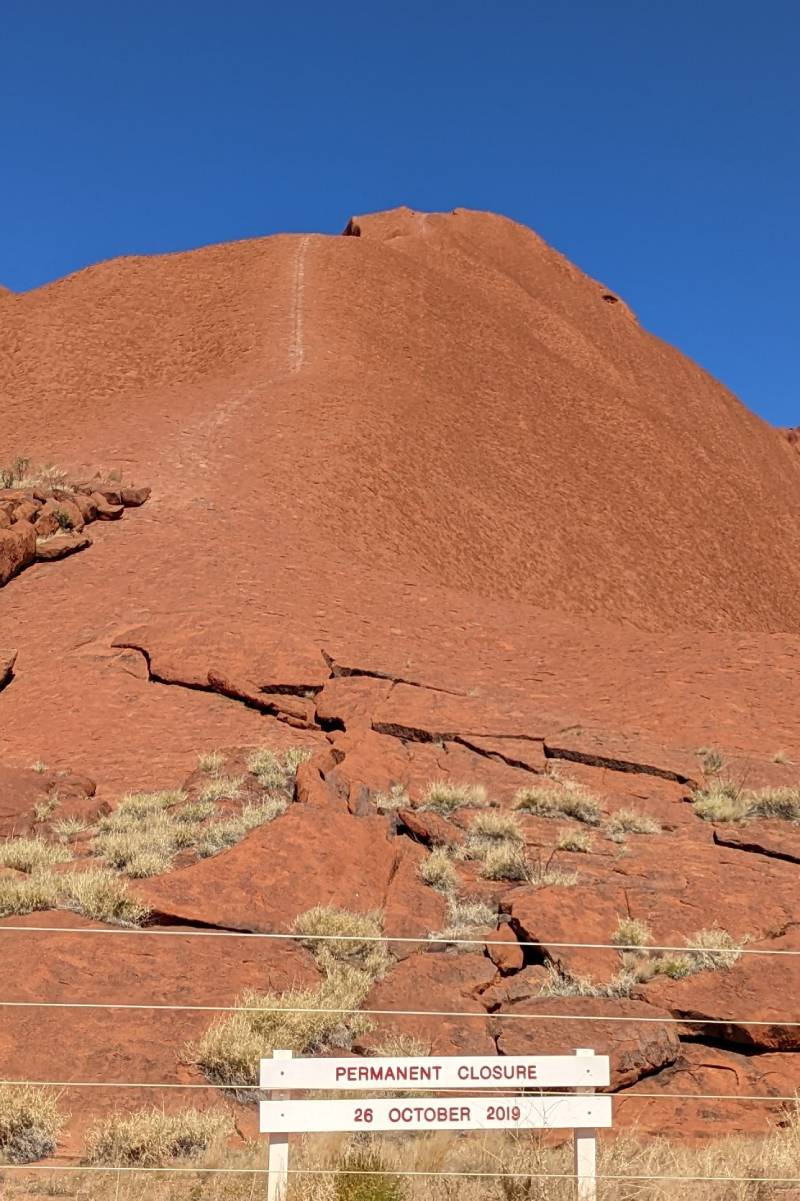
Can I take photos of Uluru?
The traditional owners request that visitors avoid photographing certain sections of Uluru that hold particular cultural significance. These areas are clearly marked. Beyond those specific restrictions you’re welcome to take photos. In fact it’s quite hard not to.
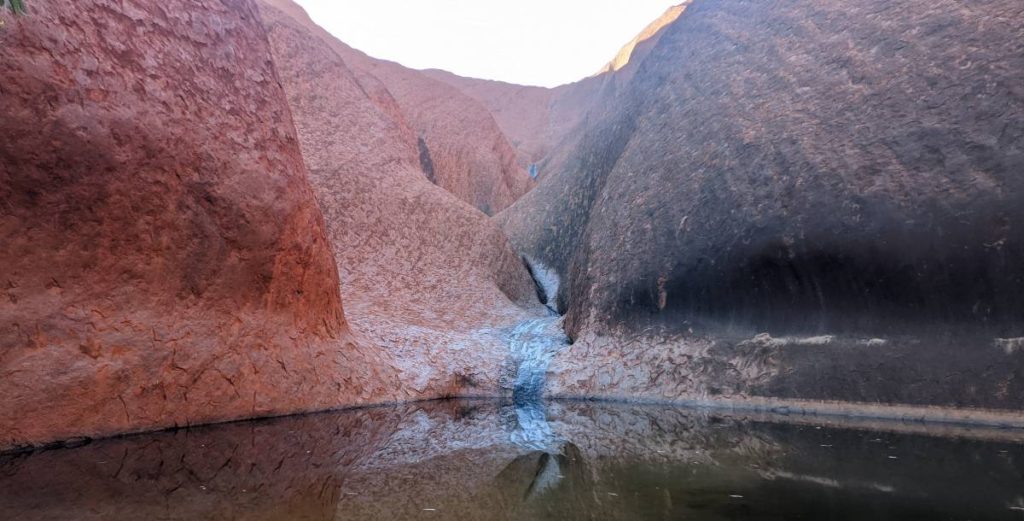
Why won’t I see many (if any) indigenous people at Uluru?
Because Uluru holds such deep cultural significance for the Aṉangu people, they tend to avoid touristy areas so they don’t become part of the tourist attraction. Mutitjulu, a 300-strong Aboriginal community, is located near the eastern end of the rock.
That said, plenty of Aṉangu work as guides, taking tourists to Uluru and sharing their culture.
Do I need a guide to visit Uluru?
No, you don’t need a guide to visit Uluru. Visitors can self-guide and take in Uluru at their own pace. This is easiest if you have your own car, but you can also take the hop-on hop-off bus. Self-guided tourists can also invest in an Uluru Audio Guide to learn about the natural wonder while they drive.
Sunrise and sunset at Uluru
Uluru is most stunning at sunrise and sunset. You can check the sunrise and sunset times for specific dates here.
- Sunrise: The sun rises as early as 5:45am in summer and as late as 7:30am in winter. The best spot to view Uluru at sunrise is Talinguru Nyakunytjaku.
- Sunset: Sunset ranges from 6pm in winter to 7:45pm in summer. The best spot to view Uluru at sunset is the Uluru Coach Sunset Viewing Area.
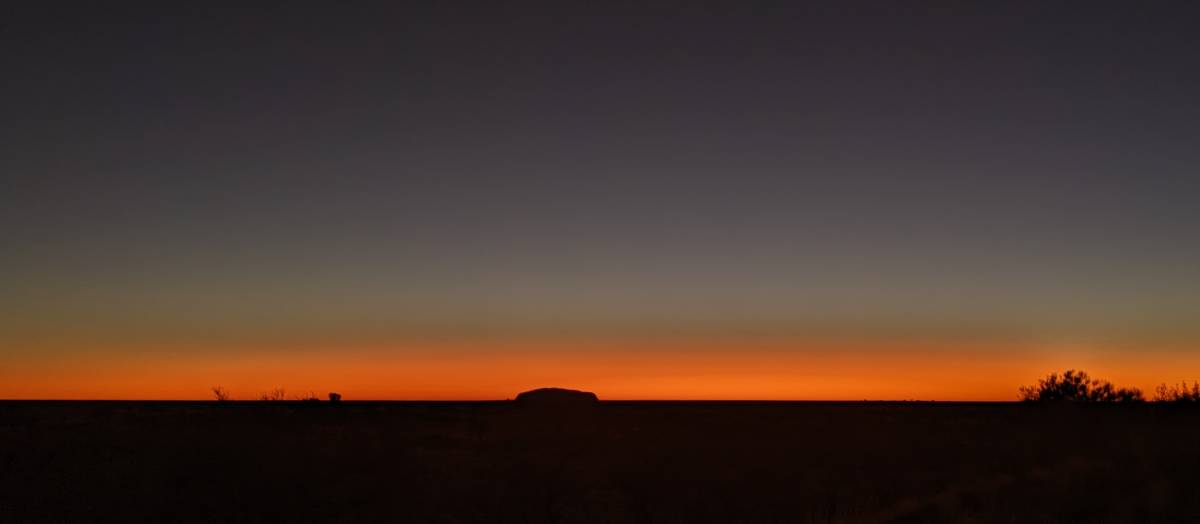
Uluru accommodation
Why is Uluru accommodation so expensive?
Uluru accommodation is pricey. This is for a couple of reasons. Yulara is a very small and very remote community, so sourcing the necessary workers and goods can be tricky and expensive for accommodation providers. And as the gateway to one of Australia’s most famous sites, rooms in Yulara tend to be popular no matter the price.
That said, there are ways to minimise costs.
Is there a backpacker hostel near Uluru (Yulara)?
Yes, Uluru has one backpacker hostel.
There are seven accommodation options in Yulara. Six are part of the same complex: Ayers Rock Resort, while the seventh is Longitude 131, a high-end 5-star retreat.
Ayers Rock Resort offers a couple of budget-friendly accommodation options:
- Outback Hotel and Lodge: This simple, comfortable hotel also serves as Yulara’s only backpacker hostel, offering a handful of male and female dorms with beds for as little as $38/night.
- Ayers Rock Campground: Uluru’s only campground offers powered and unpowered sites for as little as $30/night.
Can I camp for free at Uluru?
No, you can’t camp for free near Uluru or in Uluru-Kata Tjuta National Park. There are no public campgrounds, and roadside camping is a no-no.
If you plan to camp at Uluru, Ayers Rock Campground is your only immediate option.
The geology of Uluru
What is Uluru exactly?
Geologically speaking, Uluru is a large ‘inselberg’ (island mountain) made of sandstone. It originally formed around 600 million years ago, when Australia was part of the Gondwana supercontinent.
Uluru was slowly exposed over millions of years, as the weaker rocks and earth that surrounded it eroded away.
How big is Uluru?
Uluru measures 348m (1,142’) high, with its peak sitting 863m (2,831’) above sea level. The total perimeter of the rock is 9.4km (5.8mi).
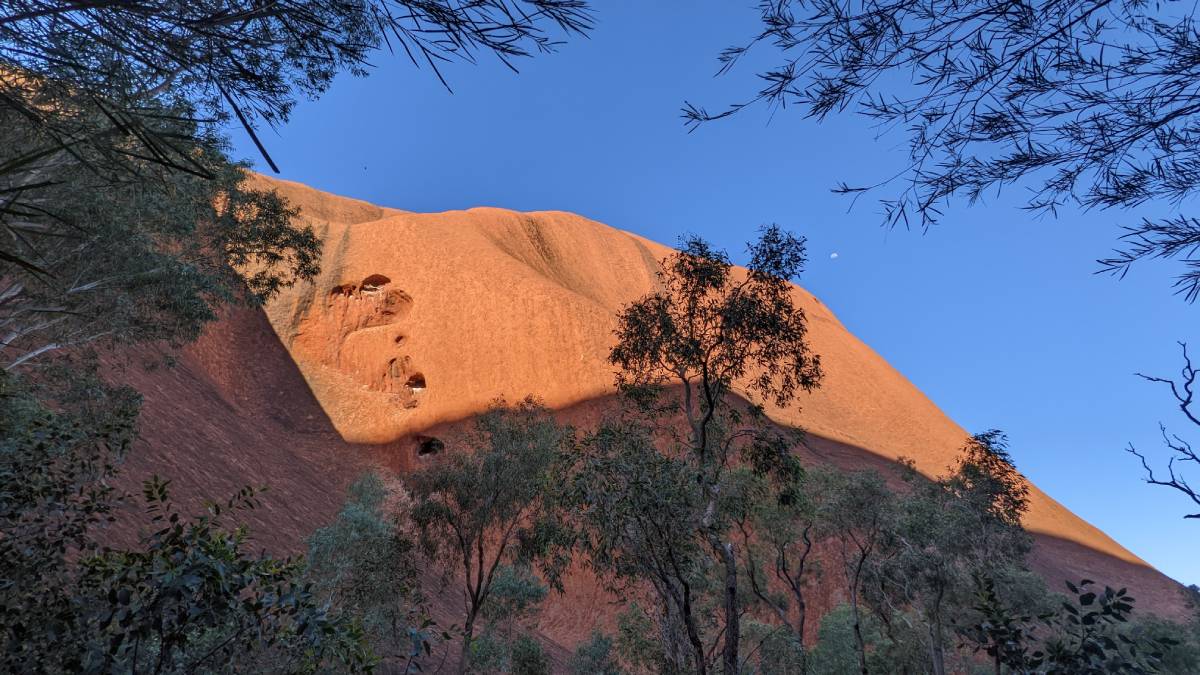
But that’s only what you can see from the surface. It is estimated that two-thirds of Uluru’s total mass is hidden underground, iceberg-style.
Uluru activities
Uluru tours
Signup to an official Uluru tour group to maximise your experience. This is a great way to learn more about Uluru and the area as well as meet other travellers.
- Guided tour: Choose from a wealth of Uluru guided tours, which go into varying degrees of detail on geology, flora and fauna, and local culture.
- Camel tour: Enjoy a unique view of Uluru by experiencing the rock from the back of a camel!
- Segway tour: Fitted with 4WD tyres ready to tackle the red earth, a Segway tour is a fun way to take in Uluru.
- Helicopter/ plane tour: Treat yourself to the most spectacular view of Uluru (and Kata Tjuta) from the seat of a plane or helicopter.
Cultural experiences
- Wintjiri Wiru light show: Combining old and new, Wintjiri Wiru is a uniquely spectacular cultural experience – drones, lasers, lights and sounds tell Dreamtime stories in the outback sky.
- Dot painting workshop: This budget-friendly experience sees you create your own keepsake, as you learn the ancient art of dot painting from a local Aṉangu artist.
- Tali Wiru dining experience: Want to treat yourself? This four-course fine dining experience, featuring meals infused with native ingredients, is held in the open air between Uluru and Kata Tjuta.
Best Uluru tour operators
Hand the admin to an expert so you can kick back and relax. The following operators offer multi-day tours that hit all the central Australian must-sees:
- Mulgas Adventures: A Northern Territory tour company with a focus on the red centre, Mulgas Adventures offers a truly authentic tour experience at the right price.
- Intrepid travel: A big name in the adventure tour space, there’s something for everyone in Intrepid’s wide range of Uluru tour options.
- Untamed Escapes: If you plan to begin or end your adventure in Adelaide, Untamed Escapes’ environmentally-focused, small group tours might be the perfect option.
Nearby attractions
For an area largely defined by its nothingness, central Australia has a surprising amount of spectacular landmarks (remembering ‘nearby’ is a relative term in these parts). After you’ve soaked up Uluru, be sure to check out:
- Kata Tjuta/Mount Olga: With its shared geology, Kata Tjuta (Mt Olga) can be considered Uluru version two. A 45-minute drive west, this formation features a succession of domes, the highest of which rises 546m (1,791’) from the surrounding plain, making it 198m (650’) taller than Uluru.
- Kings Canyon: A spectacular natural wonder found 3.5 hours north of Uluru, Kings Canyon has been called a ‘living plant museum’, as it’s home to a collection of flora and fauna found nowhere else, as well endless – and endlessly inviting – permanent rock pools.
